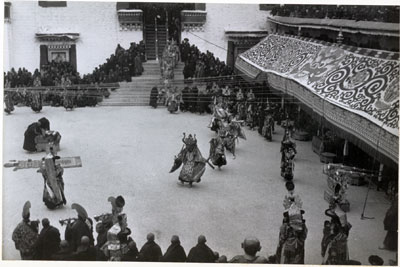
BMR.86.1.53.4 (Album Print black & white)


BMR.86.1.53.4 (Album Print black & white)

Frederick Spencer Chapman
Hugh E. Richardson
February 10th 1937
Lhasa > Potala > Deyang shar
BMR.86.1.53.4
Dancing
Print gelatin silver
British Diplomatic Mission to Lhasa 1936-37
Donated to the British Museum in 1986 by Hugh E. Richardson
C.8 [view film roll]
F. S. Chapman Collection in the Pitt Rivers Museum
1998.131.622.1
Notes on print/mount - This contact print has been made using Velox printing out paper and the trade name in an oval can be seen on the back of the print. The batch development number '631' has been printed on the back in red ink. [MS 04/04/2006]
Manual Catalogues - Caption in Chapman's hand-written list of negatives made whilst on the Mission to Lhasa, 1936-7 [See PRM Manuscripts Collection]: '1/2 Black hat crowd and the masked man returning’; PRM Manuscripts Collection: ‘List of Tibetan Prints and Negatives’ - Book 3: ‘10/1 - Towards the end of the dance all the masked dancers return and form an inner circle to the Black Hat dancers. While monk (on left) prepare charms to exorcise the ‘corpse’ ‘ [MS 06/04/2006]
Other Information - Images prefixed with 'C' comprise a group of negatives containing images of and around the Potala and dancers at the Potala taken on February 10th 1937 [MS 04/04/2006]
Other Information - Description: "Then comes the serious business of the day. The skeletons scamper away, and the trumpets proclaim the chief actor, a black hat magician who is to lead the remainder of the ceremony. He is dressed in brocade robes embroidered with the dorje thunder bolt and with skulls. He wears an apron of bones and on his head is a tall black hat with an enormous brim and topped by a fan-shaped ornament of peacock's feathers. He dances still to the same rhythm which continues through the whole ceremony, weaving spells with the skull which he holds in one hand and the Dorje which he holds in the other. His movements are fluid and graceful beyond those of the other dancers. Soon a procession of monks appears, bearing censers and sticks of incense and blowing shrill trumpets. They lead into the dancing floor some 20 black hat dancers dressed like the chief magician but without the bone apron. They slowly dance their way round the court until they are arranged about it in a circle." ['Lhasa Mission, 1936: Diary of Events', Part XIV p.2 , written by Richardson] [MS 06/04/2006]
Other Information - Setting: The “Tse Gutor” masked dances being performed by monks in the eastern courtyard of the Potala. This ceremony takes place at the end of the Tibetan calendar and is designed to purge the sins of the past year. At the Potala it is performed by the monks of Namgye Tratsang who undergo training for many years. Richardson gives a detailed account of this event in “Ceremonies of the Lhasa Year”: “The chief is the Chinese priest Hashang, a huge heavily padded figure in a scarlet robe and with a massive, smiling bald-headed mask. With him are two tiny child-like figures, two more in the dress of Indian sadhus, and two with death’s head masks” (1993:116 – 123) Then two more masked dancers arrive - one representing Shinje the lord of the dead and protector of the Buddhist faith and the other, the stag-headed Tsamuntri. Other dancers portray wrathful protector deities such as Dorje Jigje (with a bull’s head), Tamdrin (the horse-headed), a red masked Mahakala and the black-faced Lhamo. [CH 2003]
Other Information - Location: This photograph seems to have been taken from the balcony directly above the entrance to the eastern courtyard. The Mission had been offered use of the balcony above this one but, as this was better for photographic purposes, Gould apparently allowed the Chinese delegation to use the higher level. Chapman and Doctor Morgan were in charge of photography on this occasion and Chapman comments that he set up seven cameras (presumably a combination of cine and still) to record the proceedings [see ['Lhasa: The Holy City', F. Spencer Chapman, London: Chatto & Windus, 1938, p. 301] [MS 06/04/2006]
For Citation use:
The Tibet Album.
"Black Hat and masked dancers at Tse Gutor"
05 Dec. 2006. The British Museum.
<http://tibet.prm.ox.ac.uk/photo_BMR.86.1.53.4.html>.
For more information about photographic usage or to order prints, please visit the The British Museum.
© The British Museum